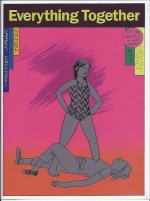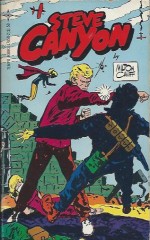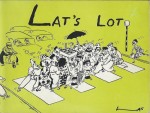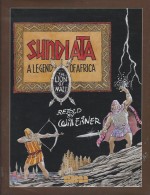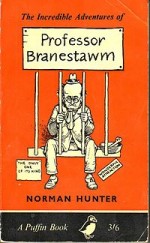
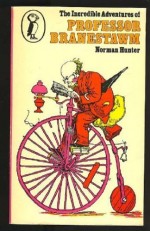
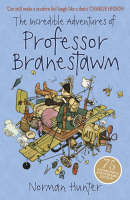
By Norman Hunter, illustrated by W. Heath Robinson (Puffin/Red Fox and others)
ISBNs: PSS33 (1969 Puffin edition)Â Â Â Â Â Â Â Â Â Â Â Â 978-1-86230-736-0 (Red Fox 2008)
Although I’m pushing a number of comic-based kids books this week I’d be utterly remiss if I didn’t also include at least one example of the venerably traditional illustrated novel which used to be the happily inescapable staple of bedtime for generations. This particular example is particularly memorable, not simply because it’s a timeless masterpiece of purely English wit and surreal invention, but also because most editions are blessed with a wealth of stunning pictures by an absolute master of absurdist cartooning and wry, dry wit.
Norman George Lorimer Hunter was born on November 23rd, 1899in Sydenham; a decade after that part of Kentbecame part of the ever-expanding Countyof London. He started work as an advertising copywriter and moved into book writing soon after with Simplified Conjuring for All: a collection of new tricks needing no special skill or apparatus for their performance with suitable patter, Advertising Through the Press: a guide to press publicity and New and Easy Magic: a further series of novel magical experiments needing no special skill or apparatus for their performance with suitable patter published between 1923 and 1925.
He was working as a stage magician in Bournemouthduring the early 1930s when he first began concocting the genially explosive exploits of the absolute archetypical absent-minded boffin for radio broadcasts. The tales were read by the inimitable Ajax – to whom the first volume is dedicated – as part of the BBC Home Service’s Children’s Hour.
In 1933 The Incredible Adventures of Professor Branestawm was published in hardback with 76 enthrallingly intricate illustrations by W. Heath Robinson to great success, prompting the sequel Professor Branestawm’s Treasure Hunt (illustrated by James Arnold & George Worsley Adamson) four years later.
During WWII Hunter moved back to Londonand in 1949 emigrated to South Africawhere he worked outside the fiction biz until his retirement. He returned to Britainin 1970, following the release of Thames Television’s Professor Branestawm TV series which adapted many of the short stories from the original books in the summer of 1969.
Following the show Hunter resumed writing: another 11 Branestawn tomes between 1970-1983, plus a selection of supplemental books including Professor Branestawm’s Dictionary (1973), …Compendium of Conundrums, Riddles, Puzzles, Brain Twiddlers and Dotty Descriptions (1975), …Do-it-yourself Handbook (1976) and many magic-related volumes.
Norman Hunter died in 1995.
William Heath Robinson was born on May 31st 1872 into something of an artistic dynasty. His father Thomas was chief staff artist for Penny Illustrated Paper. His older brothers Thomas and Charles were also illustrators of note.
After schooling William tried unsuccessfully to become a watercolour landscape-artist before returning to the family trade and in 1902 produced the fairy story ‘Uncle Lubin’ before contributing regularly to The Tatler, Bystander, Sketch, Strand and London Opinion. During this period he developed the humorous whimsy and penchant for eccentric, archaic-looking mechanical devices that made him a household name.
During the Great War he uniquely avoided the Jingoistic stance and fervour of his fellow artists, preferring instead to satirise the absurdity of conflict itself with volumes of cartoons such as The Saintly Hun. Then, after a 20-year career of phenomenal success and creativity in cartooning, illustration and particularly advertising, he found himself forced to do it again in World War Two.
He died on13th September 1944.
Perhaps inspired by the Branestawm commission, Heath Robinson’s 1934 collection Absurdities hilariously describes the frail resilience of the human condition in the Machine Age and particularly how the English deal with it all. They are also some of his funniest strips and panels. Much too little of his charming and detailed illustrative wit is in print today, a situation that cries out for Arts Council Funding or Lottery money, perhaps more than any other injustice in the sadly neglected field of cartooning and Popular Arts.
The first inspirational Professor Branestawm storybook introduces the dotty, big-domed, scatterbrained savant as a ramshackle cove with five pairs of spectacles – which he generally wears all at once – and his clothes held together with safety pins …probably because the many explosions he creates always blow his buttons off.
The wise buffoon spends most of his days thinking high thoughts and devising odd devices in his “Inventory†whilst his mundane requirements are taken care of by dotty, devoted, frequently frightened or flustered housekeeper Mrs. Flittersnoop. Branestawm’s best chum is the gruff Colonel Dedshott of the Catapult Cavaliers, although said old soldier seldom knows what the scientist is talking about…
The over-educated inspirationalist and his motley crew first appeared in ‘The Professor Invents a Machine’ which saw the debut of an arcane device that moved so quickly that Branestawm and Dedshott were carried a week into the past and accidentally undid a revolution in Squiglatania – and ended up upsetting everybody on both sides of the argument.
In ‘The Wild Waste-Paper’ Mrs. Flittersnoop’s incessant tidying up caused a spill of the Professor’s new Elixir of Vitality and the consequent enlargement and animation of a basket full of furiously angry bills, clingy postcards and discarded envelopes, whilst in
‘The Professor Borrows a Book’ the absent-minded mentor mislaid a reference tome and had to borrow another from the local library.
A house full of books is the worst place to lose one, and when the second one went walkies Branestawm had to borrow a third or pay the fine on the second. By the time he’d finished the Professor had checked out fourteen copies and was killing himself covertly transporting it from library to library…
When his stuff-stuffed house was raided by ‘Burglars!’ the shocked and horrified thinker was driven to concoct the ultimate security system. It was the perfect device to defend an Englishman’s Castle – unless he was the type who regularly forgot his keys and that he had installed an anti-burglar machine…
When he lost a day because he hadn’t noticed his chronometer had stopped, the Professor invented a new sort of timepiece that never needed winding. Even the local horologist wanted one.
Sadly the meandering mentalist had forgotten to add a what-not to stop them striking more than twelve and as the beastly things inexorably added one peal every hour soon there were more dings than could fit in any fifty-nine minutes. ‘The Screaming Clocks’ quickly became most unwelcome and eventually an actually menace to life and limb…
The Professor often thought so hard that he ceased all motion. Whilst visiting ‘The Fair at Pagwell Green’ Mrs. Flittersnoop and Colonel Dedshott mistook a waxwork of the famously brilliant bumbler for the real thing and brought “him†home to finish his pondering in private. Sadly the carnival waxworks owner alternatively believed he had a wax statue that had learned to talk…
‘The Professor Sends an Invitation’ saw the savant ask Dedshott to tea but forget to include the laboriously scripted card. By means most arcane and convoluted, the doughty old warrior received an ink-smudged blotter in an addressed envelope and mobilised to solve a baffling cipher. Of course his first port-of-call had to be his clever scientific friend – who had subsequently forgotten all about upcoming culinary events…
‘The Professor Studies Spring Cleaning’ found Branestawm applying his prodigious intellect and inventive acumen to the seasonal tradition that so vexed Mrs. Flittersnoop before inevitably finding a way to make things worse. He thus constructed a house-engine that emptied and cleaned itself. Of course it couldn’t really tell the difference between sofa, couch cupboard or housekeeper…
‘The Too-Many Professors’ appeared when the affable artificer invented a solution which brought pictures to life. Flittersnoop was guardedly impressed when illustrations of apples and chocolates became edibly real but utterly aghast when a 3-dimensional cat and elephant began crashing about in the parlour.
So it was pretty inevitable that the foul-smelling concoction would be spilled all over the photograph albums…
In a case of creativity feeding on itself, ‘The Professor Does a Broadcast’ relates how the brilliant old duffer was asked to give a lecture on the Wireless (no, not about radio, but for it…). Unaccustomed as he was to public speaking, the tongue-tied boffin had Dedshott rehearse and drill him until he could recite the whole speech in eleven minutes. Of course the scheduled programme was supposed to last half an hour…
A grand Fancy Dress Ball resulted in two eccentric pillars of Pagwell Society wittily masquerading as each other. Naturally ‘Colonel Branestawm and Professor Dedshott’ were a great success but when the Countess of Pagwell‘s pearls were purloined whilst the old duffers changed back to their regular attire nobody noticed the difference or believed them…
‘The Professor Moves House’ found the inventor forced to rent larger premises because he had filled up the old one with his contraptions. However Branestawm’s attempts to rationalise the Moving Men’s work patterns proved that even he didn’t know everything. At least the disastrous ‘Pancake Day at Great Pagwell’ rescued his reputation when his magnificent automatic Pancake-Making Machine furiously fed a multitude of friends and civic dignitaries. The Mayor liked it so much he purchased it to lay all the municipality’s pavements…
This gloriously enchanting initial outing ends with ‘Professor Branestawm’s Holiday’ as the old brain-bonce finally acquiesced to his housekeeper’s urgent urgings and went for a vacation to the seaside. Keen on swotting up on all things jellyfish the savant set off but forgot to check in at his boarding house, prompting a desperate search by Dedshott, Flittersnoop and the authorities.
Things were further complicated by a Pierrot Show which boasted the best Professor Branestawn impersonator inBritain: so good in fact that even the delinquent dodderer’s best friends could not tell the difference.
With the performer locked up in a sanatorium claiming he wasn’t a Professor, it was a lucky thing the one-and-only scatty scholar was unable to discern the difference between a lecture hall and a seaside show-tent…
As I’ve already mentioned, these astonishingly accessible yarns were originally written for radio and thus abound with rhythmic cadences and onomatopoeic sound effects that just scream to be enjoyed out loud. This eternally fresh children’s classic, augmented by 76 of Heath-Robinson’s most memorable character caricatures and insane implements, offer some of the earliest and most enduring example of spiffing techno-babble and fabulous faux-physics – not to mention impressive iterations of the divine Pathetic Fallacy in all its outrageous glory – and no child should have to grow up without visiting and revisiting the immortal, improbable Pagwell Pioneer.
In 2008 a 75th Anniversary edition of The Incredible Adventures of Professor Branestawm was released by Red Fox but you’re just a likely to find this uproarious ubiquitous marvel in libraries, second-hand shops or even jumble sales – so by all means do…
© 1933 Norman Hunter. All rights reserved.

